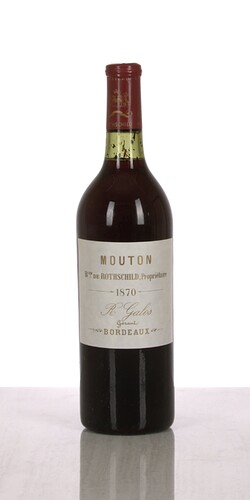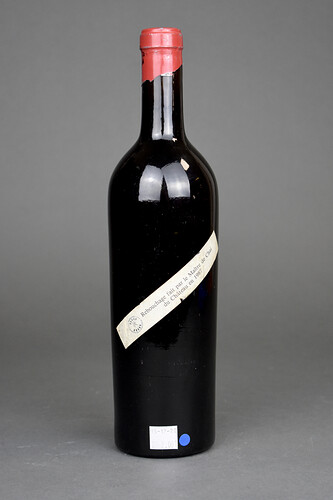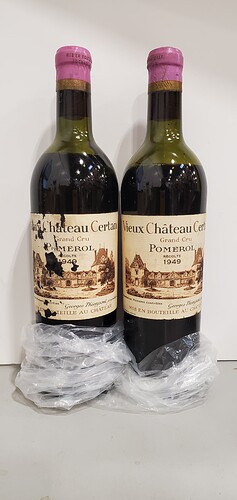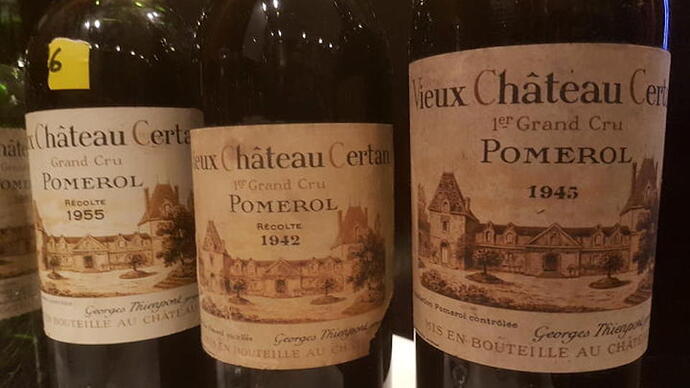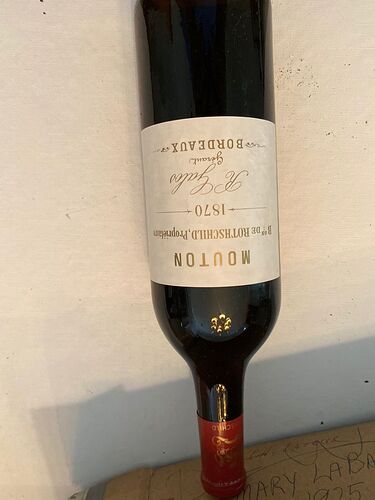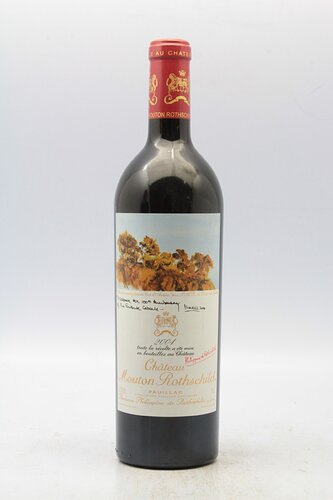A WARNING ABOUT SUSPECT BOTTLES IN HERITAGE AUCTION’S “SHOWCASE” ONLINE AUCTION
This is a warning about four single bottle lots of very old Bordeaux, ranging from 76 to 155 years old, that are being offered in Heritage Auction’s “Showcase” online auction, which ends on Aug 21st at 6:00 PM Central Daylight Time. https://wine.ha.com/c/search/results.zx?dept=4313&mode=live&auction_name=24182&ic=Items-OpenAuctions-Open-BrowseViewLots-071713 The four lots in question are a purported 1870 Chateau Mouton Rothschild (Lot 31009), 1874 Chateau Mouton Rothschild (Lot 31010), 1945 Chateau Lafite Rothschild (Lot 31002) and 1949 Chateau Vieux Chateau Certan (Lot 31018). These four bottles came from a single source, which was described to me in an email from Heritage on August 14, 2021 as follows: “The ancients from a Texas pro were purchased through natural distribution channels. He was an exec at a prominent importer/distributor and purchased the wines through a designated negociant.”
Three of the four of the “ancient” lots bear importer strip labels from American Wine & Importing Company of Dallas Texas, a company which existed from 1967 until approximately 2004. Two of the three strip labels list the fluid quantity as one pint, 8 fluid ounces, which means that the original bottles were sold prior to September 1976, when the BATF regulations requiring the use of metric volume measurements went into effect.
For three of the four bottles - - the 1870 Mouton, 1874 Mouton and 1945 Chateau Lafite - - the catalog claims that the bottles were “reconditioned by chateau.” No date for the alleged reconditioning is provided as to the two Mouton bottles. The 1870 bottle bears the modern long maroon-colored capsules introduced on the chateau’s 150th anniversary vintage (2003) – released in 2006. The 1945 Chateau Lafite is listed in the Heritage electronic catalog as having been “reconditioned by chateau 1989.” But there is apparently no labeling on the bottles to confirm that the bottles were reconditioned by the chateau, and the consignor has apparently provided no proof of chateau reconditioning. I have repeatedly asked for such proof from Heritage since August 13, but Heritage has failed and refused to provide it. Similarly, there is nothing in the catalog to indicate that any of the capsules on these bottles have been cut in order to verify the printed content of the cork.
The fourth bottle – 1949 Vieux Chateau Certan – has not been recorked. It might be authentic, but it contains a notable labeling discrepancy from the chateau’s other bottles from the 1949 vintage (and the vintages from 1942 to 1961) – the word Récolte and the year 1949 appear on the same line. (I have sent an inquiry to the chateau in the hope of obtaining an answer). The short pink capsule on the bottle shows clear evidence of prior removal by someone, but there is no indication that the capsule was removed by Heritage Auctions or that the vintage and labeling on the cork has been verified.
1870 Mouton Rothschild
The 1870 Mouton Rothschild has a relatively new, pristine label. There is no importer strip label on this bottle . At least based upon the catalog description, and the silence from Heritage in response to my inquiries, apparently there is no back label or strip label indicating that this bottle was recorked/reconditioned by the chateau. (The absence of a label indicating the volume and alcohol content technically make it illegal to sell this bottle.)
The content and printing on the label appear to be an accurate reproduction of the original label for the 1870 vintage. The wine bears a long maroon-colored Chateau Mouton Rothschild capsule, which was initially used on the 150th anniversary vintage (2003), which was physically released in 2006. The catalog description states: “reconditioned by chateau, excellent color.”
Unlike Lafite Rothschild, Mouton Rothschild did not offer US recorking services. In order to get bottles of Mouton Rothschild recorked by the chateau, you had to bring the bottles to the chateau. I am told that Mouton was very selective as to the customers for whom rebouchage would be performed. Assuming this bottle was “reconditioned” by the chateau, based upon the long maroon chateau label, that reconditioning would have had to take place in 2006 or thereafter – apparently after American Wine & Importing was out of business.
Based on the catalog description (and from what is visible in the one photo supplied on the Heritage website), the capsule has not been cut to verify the contents of the cork and the claimed rebouchage.
Under these circumstances, in my opinion there is no credible evidence that this is a bottle of 1870 Mouton Rothschild which has been “reconditioned by the chateau” as claimed in the catalog. Without proof that this bottle was reconditioned by the chateau and that the vintage is 1870 as claimed, this bottle must be viewed as a suspect for a refilled bottle.
1874 Mouton Rothschild
The 1874 Mouton Rothschild has an older, partially faded label. The fonts on that label appear to match the original one in use on the 1874 vintage Mouton labels. There is a long solid red capsule on this wine which, from its appearance, did
NOT originate from Chateau Mouton Rothschild.
This bottle has an American Wines & Importing Company capsule which lists the fluid content as 750 ml (i.e. post-September 1976 strip label). That strip label indicates the bottle was obtained from Whitwhams in the UK. The cork appears to be protruding slightly protruding cork, which is acknowledged in the catalog description, which states: “ts, bsl, wrl, spc, reconditioned by chateau, excellent color”
As with the 1870 Mouton, there is no visible evidence that this bottle was reconditioned by the chateau and there is apparently no back label or strip label so stating. Similarly, Heritage has repeatedly declined to answer my question as to whether the consignor provided any proof that this bottle was “reconditioned by [the] chateau” as claimed. Moreover, the plain red capsule on this bottle appears totally inconsistent with such a statement.
Based on the catalog description (and from what is visible in the one photo supplied on the Heritage website), the capsule has not been cut to verify the vintage date and the contents of the cork and the claimed rebouchage.
In my opinion, whatever may be in this bottle, it is not 1874 Mouton Rothschild that was “reconditioned by [the] chateau” as claimed.
1945 Lafite Rothschild
The 1945 Lafite Rothschild offered by Heritage has the expected bottle glass with the vintage embossed. The label appears to be correct. The capsule (the short red and black capsule used by Lafite for the 1955-1980 vintages), is different than the plain-red capsules that were on the 1945 vintage when it was originally released. In this case, the claim in the catalog was that the bottle was “reconditioned by [the] chateau [in] 1989.”
However, there is nothing on the label, and nothing in the catalog description, to confirm that the bottle was recorked/reconditioned by the chateau as claimed. All bottles recorked by Chateau Lafite (a process discontinued in 2012) bear a cork which indicates the year of recorking on the top and a strip label is glued onto the back of the bottle which indicates that the bottle was recorked by the cellarmaster of the chateau and the year it occurred. Here is a link to an article published in the Washington Post on May 27, 1992 which contains a lengthy description of the complete recorking process utilized by Chateau Lafite Rothschild. https://www.washingtonpost.com/archive/lifestyle/food/1992/05/27/a-corker-of-a-deal-from-lafite/5738a0f7-a4e3-4b84-b755-0c431f2fed33/
As stated in the Washington Post article, Lafite’s cellarmaster, Robert Revelle, “had brought with him a batch of specially prepared corks with the vintage on the side, and marked on top with a small circle around a note reading “recorked by the Maitre de Chai of Lafite in 1992.” The article also states: “As a final step, a small label stating that the wine was recorked by the Maitre de Chai of Lafite was glued to the bottle’s back.”
This is the same process which was used by Chateau Lafite for many years. I have examples of the back labels from the Lafite recorking process from 1987 and 1990 – bracketing the reconditioning in 1989 claimed in the catalog. See below.
(In addition, I would note that where the original label was replaced by a replica label supplied by Lafite as part of the recorking process, those labels were stamped with a small “Etiquette de Rebouchage” on the main label.)
I have repeatedly asked Heritage’s wine department director, Frank Martell, whether there is any strip label on the 1945 Lafite to document that the bottle was rebouchaged by Chateau Lafite. He has repeatedly failed to answer my question and stated that he refuses to engage in what he calls “dialog” about the bottles.
According to the electronic catalog description, none of the capsules on the bottles have been cut to verify whether they have vintage chateau corks and indications of rebouchage by the chateau.
In my opinion, in the absence of proof of the existence of the required strip label to confirm that the bottle was reconditioned by Chateau Lafite, or cutting the capsule to verify that the rebouchage cork indicating that this bottle was recorked by Lafite in 1989, this bottle is not what it is claimed to be – 1945 Chateau Lafite “reconditioned by [the] chateau [in] 1989.”
1949 Chateau Vieux Chateau Certan
The 1949 Chateau Vieux Certan listed in the Heritage catalog is not claimed to be a bottle recorked/reconditioned by the chateau. The bottle has short pink capsule, as it should, but in this instance it is obvious from the photo that someone has removed the capsule and pushed it back on. Based on the absence of any comment in the online catalog, it does not appear that anyone attempted to examine the cork on this bottle.
While most of the label is consistent with the Chateau labeling of its 1949 vintage (including the slightly off-center printing of the various lines of text), the one potential problem is that this bottle has the word Récolte and the year (1949) on the same line. This does not match the other 1949 exemplars I have and it does not match any of the exemplars of Chateau labels from 1942 to 1961. On the vintages from 1942 to 1961, the word Récolte either appears above the vintage year, or it does not appear at all.


While there is a significant question about the label on the Heritage 1949 Vieux Chateau Certan bottle, it may or may not be authentic.
